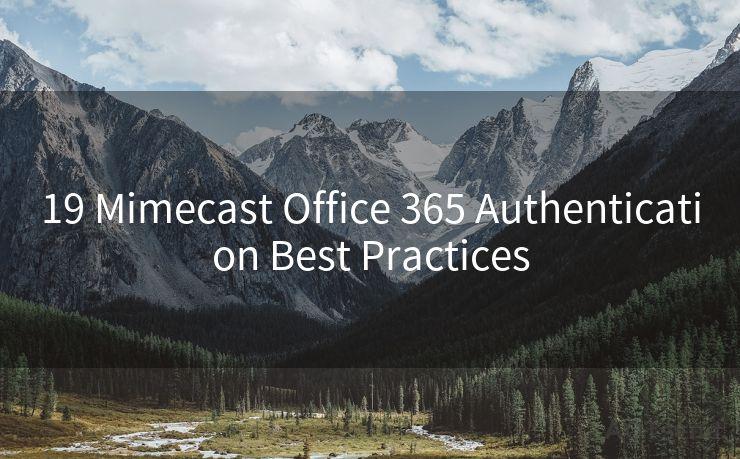19 Mimecast Office 365 Authentication Best Practices




1. Introduction
In the modern business environment, where data security and privacy are paramount, it's crucial to follow best practices for authentication, especially when using cloud-based services like Office 365. Mimecast, a leading email security and archiving solution, integrates seamlessly with Office 365, enhancing its security features. In this article, we'll explore 19 best practices for Mimecast Office 365 authentication to ensure robust security and optimal performance.
2. Enable Multi-Factor Authentication (MFA)
One of the first and foremost authentication best practices is to enable Multi-Factor Authentication (MFA). This adds an extra layer of security, requiring not just a password but also a second form of verification, such as a code sent to a mobile device.
3. Utilize Strong Passwords
Strong, unique passwords are essential for any authentication process. Encourage users to create complex passwords that are difficult to guess and regularly update them.
4. Implement Single Sign-On (SSO)
Single Sign-On (SSO) simplifies the authentication process by allowing users to access multiple applications with a single set of credentials. This reduces the risk of credential theft or loss.
5. Regular Audit of Accounts and Permissions
Conduct regular audits of user accounts and permissions to ensure that only authorized individuals have access to sensitive data. This helps identify and remove any unauthorized or dormant accounts.
6. Utilize Mimecast's Advanced Authentication Features
Mimecast offers advanced authentication features like DMARC, DKIM, and SPF checking to validate incoming and outgoing emails. Ensure these are properly configured to enhance email security.
7. Train Employees on Security Best Practices
Regularly train employees on security best practices, including creating strong passwords, recognizing phishing attempts, and understanding the importance of MFA.
8. Monitor Suspicious Login Attempts
Utilize Mimecast's reporting and monitoring tools to identify and respond to suspicious login attempts promptly.
9. Enforce Least Privilege Access
The principle of least privilege ensures that users only have the necessary access rights to perform their job functions, reducing the risk of unauthorized access or data leakage.
10. Update and Patch Regularly
Keep Mimecast and Office 365 updated with the latest security patches and updates to protect against known vulnerabilities.
11. Secure Mobile Access
With remote work becoming more common, it's essential to secure mobile devices used to access Office 365. Implement mobile device management solutions to ensure secure authentication.
12. Implement Role-Based Access Control (RBAC)
RBAC allows administrators to assign permissions based on job roles, ensuring that users only have access to the information they need.
13. Utilize Secure Protocols
Ensure that all connections to Office 365 and Mimecast use secure protocols like HTTPS and SSL/TLS.
14. Regular Backup and Recovery Planning
Regularly backup data and have a recovery plan in place to minimize downtime in case of a security incident.

15. Implement Security Information and Event Management (SIEM)
A SIEM system can help identify and respond to security threats in real-time by collecting and analyzing log data from various sources.
16. Two-Step Verification for Admin Accounts
Enable two-step verification, especially for administrator accounts, to add an extra layer of protection against unauthorized access.
17. Regular Penetration Testing
Conduct regular penetration testing to identify and address any vulnerabilities in your Mimecast and Office 365 setup.
18. Monitor Third-Party Apps
Regularly monitor and review third-party applications that have access to your Office 365 data to ensure they are secure and up to date.
19. Encourage User Feedback
Encourage users to report any suspicious activity or security concerns they may encounter while using Mimecast or Office 365.
🔔🔔🔔
【AOTsend Email API】:AOTsend is a Managed Email Service for sending transactional emails. Support Email Types: reminders, authentication, confirmations, notifications, verification codes, invoices, password resets, account activations, billing statements, two-factor authentication (2FA), and one-time passwords (OTP) emails, etc. $0.28 per 1000 Emails. 99% Delivery, 98% Inbox Rate.
You might be interested in:
Why did we start the AOTsend project, Brand Story?
What is a Managed Email API, How it Works?
Best 25+ Email Marketing Platforms (Authority,Keywords&Traffic Comparison)
Best 24+ Email Marketing Service (Price, Pros&Cons Comparison)
Email APIs vs SMTP: How they Works, Any Difference?
Conclusion
By following these 19 Mimecast Office 365 authentication best practices, organizations can significantly enhance their data security and privacy. It's crucial to stay vigilant and proactive in the face of evolving cyber threats. Remember, security is everyone's responsibility, and a robust security posture requires a combination of technology, policies, and user education.




Scan the QR code to access on your mobile device.
Copyright notice: This article is published by AotSend. Reproduction requires attribution.
Article Link:https://www.mailwot.com/p3051.html



